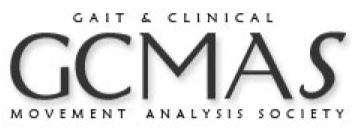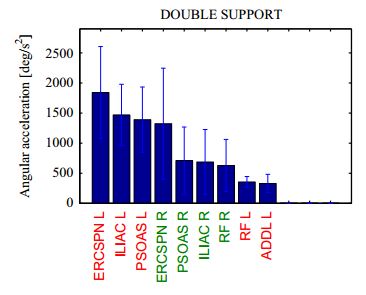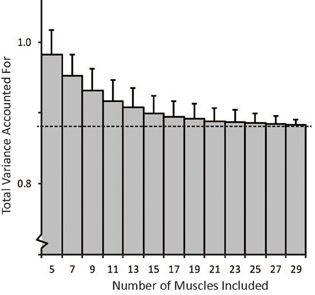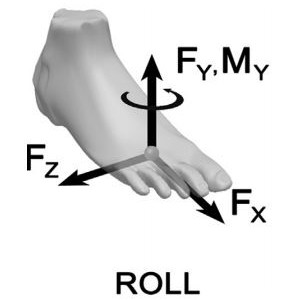Kat Steele presents at Gait & Clinical Movement Analysis Society Conference:
Quantifying altered muscle properties with ultrasound elastography and musculoskeletal simulation
Newark, DE (June 24-27, 2014)

Kat Steele presents at Gait & Clinical Movement Analysis Society Conference:
Quantifying altered muscle properties with ultrasound elastography and musculoskeletal simulation
Newark, DE (June 24-27, 2014)

Journal article accepted in Journal of Biomechanics:
Contributions of individual muscles to the sagittal- and frontal-plane angular accelerations of the trunk in walking.
This study was conducted to analyze the unimpaired control of the trunk during walking. Studying the unimpaired control of the trunk reveals characteristics of good control. These characteristics can be pursued in the rehabilitation of impaired control. Impaired control of the trunk during walking is associated with aging and many movement disorders. This is a concern as it is considered to increase fall risk. Muscles that contribute to the trunk control in normal walking may also contribute to it under perturbation circumstances, attempting to prevent an impending fall. Knowledge of such muscles can be used to rehabilitate impaired control of the trunk. Here, angular accelerations of the trunk induced by individual muscles, in the sagittal and frontal planes, were calculated using 3D muscle-driven simulations of seven young healthy subjects walking at free speed. Analysis of the simulations demonstrated that the abdominal and back muscles displayed large contributions throughout the gait cycle both in the sagittal and frontal planes. Proximal lower-limb muscles contributed more than distal muscles in the sagittal plane, while both proximal and distal muscles showed large contributions in the frontal plane. Along with the stance-limb muscles, the swing-limb muscles also exhibited considerable contribution. The gluteus medius was found to be an important individual frontal-plane control muscle; enhancing its function in pathologies could ameliorate gait by attenuating trunk sway. In addition, since gravity appreciably accelerated the trunk in the frontal plane, it may engender excessive trunk sway in pathologies. PDF

Journal article accepted in Frontiers in Computational Neuroscience:
The number and choice of muscles impact the results of muscle synergy analyses
One theory for how humans control movement is that muscles are activated in weighted groups or synergies. Studies have shown that electromyography (EMG) from a variety of tasks can be described by a low-dimensional space thought to reflect synergies. These studies use algorithms, such as nonnegative matrix factorization, to identify synergies from EMG. Due to experimental constraints, EMG can rarely be taken from all muscles involved in a task. However, it is unclear if the choice of muscles included in the analysis impacts estimated synergies. The aim of our study was to evaluate the impact of the number and choice of muscles on synergy analyses. We used a musculoskeletal model to calculate muscle activations required to perform an isometric upper-extremity task. Synergies calculated from the activations from the musculoskeletal model were similar to a prior experimental study. To evaluate the impact of the number of muscles included in the analysis, we randomly selected subsets of between 5 and 29 muscles and compared the similarity of the synergies calculated from each subset to a master set of synergies calculated from all muscles. We determined that the structure of synergies is dependent upon the number and choice of muscles included in the analysis. When five muscles were included in the analysis, the similarity of the synergies to the master set was only 0.57 ± 0.54; however, the similarity improved to over 0.8 with more than ten muscles. We identified two methods, selecting dominant muscles from the master set or selecting muscles with the largest maximum isometric force, which significantly improved similarity to the master set and can help guide future experimental design. Analyses that included a small subset of muscles also over-estimated the variance accounted for (VAF) by the synergies compared to an analysis with all muscles. Thus, researchers should use caution using VAF to evaluate synergies when EMG is measured from a small subset of muscles. PDF

Kat Steele presents at Neural Control of Movement
Using musculoskeletal modeling and simulation to investigate the accuracy and reliability of muscle synergies
San Juan, Puerto Rico (April 17-20, 2013)

Journal article accepted in Journal of Biomechanics
A rolling constraint reduces ground reaction forces and moments in dynamic simulations of walking, running, and crouch gait
Recent advances in computational technology have dramatically increased the use of muscle-driven simulation to study accelerations produced by muscles during gait. Accelerations computed from muscle-driven simulations are sensitive to the model used to represent contact between the foot and ground. A foot-ground contact model must be able to calculate ground reaction forces and moments that are consistent with experimentally measured ground reaction forces and moments. We show here that a rolling constraint can model foot-ground contact and reproduce measured ground reaction forces and moments in an induced acceleration analysis of muscle-driven simulations of walking, running, and crouch gait. We also illustrate that a point constraint and a weld constraint used to model foot-ground contact in previous studies produce inaccurate reaction moments and lead to contradictory interpretations of muscle function. To enable others to use and test these different constraint types (i.e., rolling, point, and weld constraints) we have included them as part of an induced acceleration analysis in OpenSim, a freely-available biomechanics simulation package. PDF